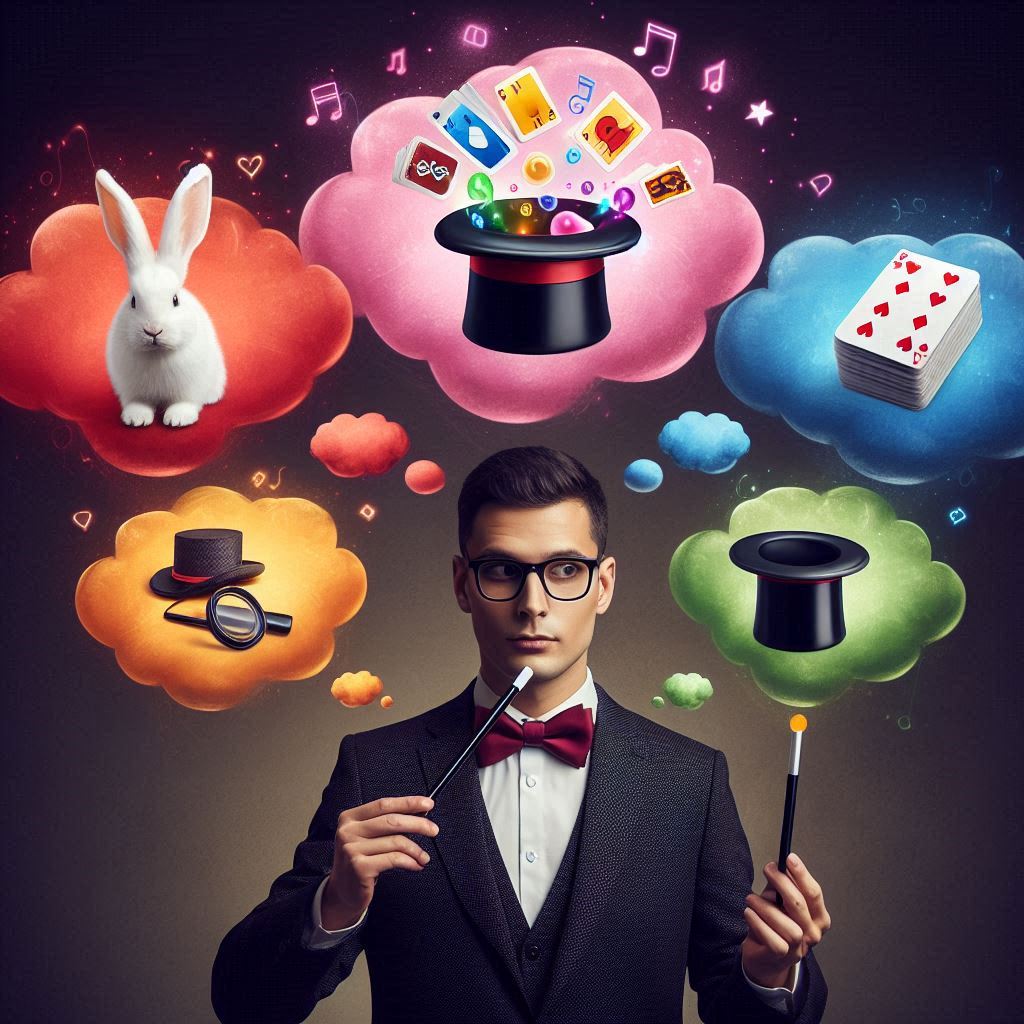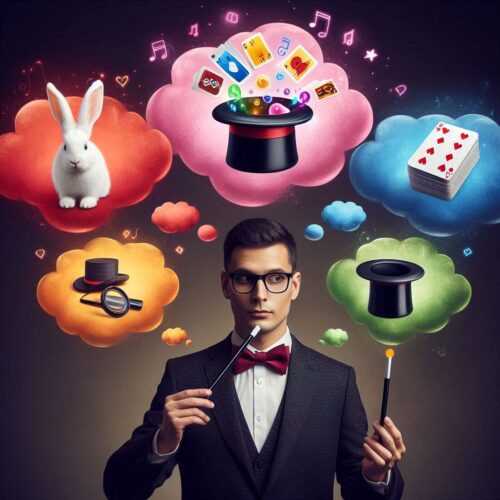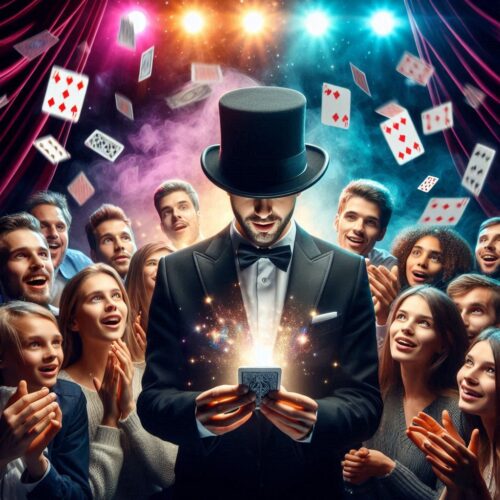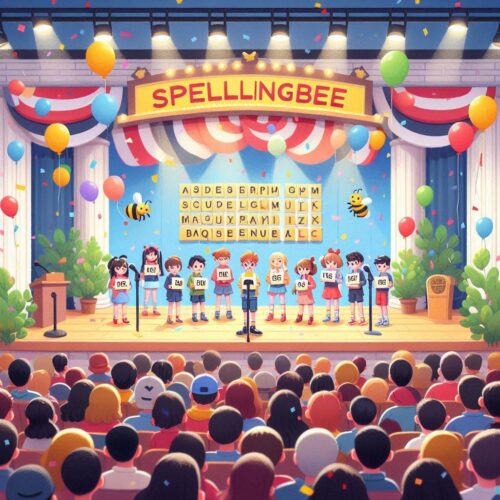Four Thought Magic Trick. You produce a stack of about forty business cards and show them to the audience. Each card features various instructions to think of a random number, a color, a popular meal, a famous actor, a politician, a country, etc. After gathering the cards, you invite another spectator to participate in the experiment. You ask him to verify that each card has different instructions.
Four Thought Illusion: A Dazzling Magic Trick
He agrees. You place the cards face down on the table and ask him to cut the cards anywhere he likes and take the card he cuts to. You then discard the other cards. The spectator concentrates on the four things listed on the card, and you correctly name the four things he was thinking of.
This effect is based on a principle known as dual reality, which requires confidence to perform, but the results are impressive. Dual reality means that the spectator’s experience of the effect differs from that of the audience, but both experiences remain valid.
In addition to confidence, this effect requires considerable preparation, especially in creating the special pack of cards used for the trick. You can handwrite or print these cards with a computer, depending on what best suits your performance style.
Preparing the Cards
The stack consists of three different types of cards:
- Two “spectator” cards (shown to the audience).
- Twenty-one “volunteer” cards (shown to your volunteer).
- Twenty “force” cards (which will be the card ultimately chosen by your volunteer).
The two spectator cards should look like this:
- Spectator Card 1
- Spectator Card 2
For the volunteer cards, create 10 of one type and 11 of another type.
All twenty force cards should look like this:
- Force Card Design
Using a sharp craft knife or guillotine, trim about a 1mm wide strip off the bottom (longest) edge of each force card. Stack them face up in the following order (from bottom to top):
- Force card
- Volunteer card
- Force card
- Volunteer card
- Force card
- Volunteer card
- … and so on, ending with two different types of “volunteer” cards on top. Finally, place the two spectator cards on top to complete the stack.
Performing the Effect
- Select Your Volunteer: Choose your volunteer and have him take a seat on stage. Pick up the stack and approach the audience, explaining that you have a special deck of cards that instruct someone to think of various things like numbers, celebrities, colors, and so on.
- Show the Stack: Display the stack face up to the spectators, allowing them to see the top card. Make sure many spectators see the card while casually picking off the top card so they can also see the second card.
- Reveal to Your Volunteer: Turn the deck toward you and remove the second card, letting everyone see it. As you walk back to your volunteer, place the two spectator cards at the bottom of the deck.
- Present to the Volunteer: Show the rest of the deck to your volunteer (but do not hand it to him). Pick off the top card (now a volunteer card) and say, “You didn’t get a chance to see. The cards have instructions for you to think of a famous actor, a color, a number … things like that.”
- Show the Second Volunteer Card: Keeping the second, different volunteer card on top, show it to him saying, “… and on this card, a famous composer, a country; you get the idea. Forty cards, each asking you to think of different things.”Here, you set up the dual reality: your description of the cards satisfies both the volunteer and the spectators. The spectators think all the other cards are like the ones they saw, while the volunteer thinks the spectators saw cards similar to what he can see.
- Ask for a Cut: Square up the cards and place them face down in front of your volunteer. Ask him to cut the deck anywhere he likes and to remove the card he cuts to, placing it face down on the table. Gather up the other cards and place them in your pocket.
- Turn Your Back: Because you trimmed all of the force cards, your volunteer will automatically cut to one of them. Now, turn your back and ask the volunteer to look at his card and think of the things it tells him to.Continuing the dual reality, the spectators think the volunteer is going to think of a random number, country, composer, etc., himself. Meanwhile, the volunteer understands that he should think of the things written on his card.
- Reveal the Thoughts: To conclude the effect, say, “OK, I’m getting it – you’re thinking of the color red, the country is Sweden, the composer is Mozart, and … a very popular meal indeed – steak and chips! Correct?” And of course, you are correct!
Four Thought – Alternative Handlings
- Reverse Positions: Reverse the positions of the spectator and volunteer cards. This allows you to show the cards to the volunteer first, then approach the audience, cutting the volunteer cards to the bottom as you do so.
- One-on-One: This effect can also be performed one-on-one by removing the spectator cards. You then show your volunteer just the two top cards as examples before cutting them to the bottom and commencing the effect.
- Misdirection: Holding the cards by the right-hand edge allows you to fan them either to your volunteer or spectators. At most, they will see the words “Think of …” on the cards, creating a powerful psychological misdirection that makes them believe all the cards are different without you having to say so.
Regardless of how you choose to perform this effect, the dual reality principle is at the forefront of modern mentalism. It can create the illusion that a performer is divining complete memories of past events, including the sights, sounds, smells, and feelings associated with a particular experience. With a bit of thought and imagination, you can adapt the force card technique used for “Four Thought” into a variety of mind-reading effects. Have fun!




